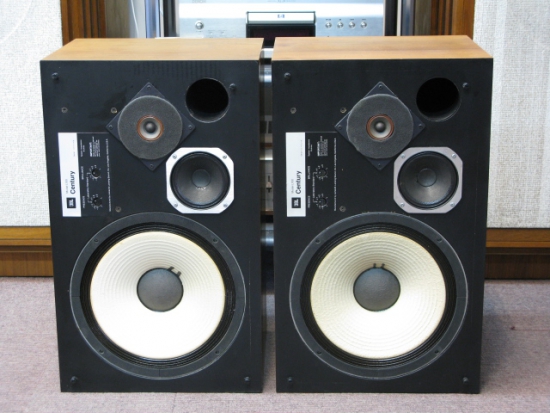JBL L100 Century Floor standing speakers
The JBL L100 Century is an unusually styled version of their 4310 control room monitor speaker developed by James B. Lansing Sound Inc. (JBL) for studios in America who wanted an enclosure of modest size. It has now been provided with a ducted port and certain changes in the tweeter, which makes i t technically identical to the 4310. The Century, however, has a unique 'chunky' plastics grille which is very durable, acoustically neutral and I think very attractive.
It is a three-way system, using a large 12-inch bass unit crossing over at 2.5 kHz to a 5-inch mid-range speaker in its own sealed wooden frame.
Above 5 kHz, the 1-1/4-inch pressure tweeter comes into use, reaching full output at 7 kHz and above. The enclosure is of 1-inch and 3/4-inch high density chipboard, lined with 1-inch glass fibre. The circular vent is 2-3/4-inch diameter, with a 12-inch duct which curves smoothly upwards into the main body of the cabinet. The internal volume is 1.6 cu.feet, with linear dimensions of 24 x 14 x 13 inches. The front grille fits easily and firmly on four polythene pegs near the corners of the cabinet, which weighs a substantial 51 lb complete. Provision is made for adjustment of the high frequency energy balance by two controls behind the grille, which are calibrated over part of their range.
The transducer units are made to very high engineering standards, using powerful magnets and cast aluminium frames. The makers claim that extremely close tolerances are held in machining and polishing the magnet pole-pieces, whilst all voice coils are of wire which is drawn to a flat ribbon, edge wound on the former so as to allow more conductor in the given gap.
The polar radiation characteristics of this system, are very typical, one feature I think being the moderate distribution of 10 kHz and above, instead of the extremely wide coverage which seems fashionable nowadays. In this respect the makers claim a distribution of "90° horizontal and vertical", referring I suppose to the average energy distribution.
There can be disadvantages in very wide energy dispersal in smaller listening rooms, with speakers standing close to large areas which are very reflective at high frequencies. They will serve to accentuate flutters and rings and detract from good diffusion, which is a basic necessity even at the higher frequencies. On listening tests, I found the freedom of adjustments in the upper register a definite need with this system. The speaker can give a very 'forward' treble response for critical listening in a monitor room or studio, which was a requirement in the original design. For most recorded material played in a normal listening room, I found the positions -3 on the presence control and -2 on the brilliance gave the best balance. Then the response was to me very clear and open, perhaps a little bright in the extreme top unless the balance controls are carefully adjusted. The measurements on the tweeter tended to confirm this.
There is no doubt, however, that in the low and mid-frequency range the Century handles the most full-blooded programme material without the slightest hint of distortion. It is a very sensitive system, even in comparison with another well known monitor speaker I tried with it. Thus it will create high intensity fields in the average room when driven from a modest 10 watt amplifier, allowing more to be spent on the speaker (necessary in this case) than on the amplifier; an eminently sensible philosophy.
The speaker uses expensively produced transducers and is well assembled and attractively finished. The JBL Century L100 is a quality loudspeaker, quite good (and in any case adjustable) in the upper range and of the very best in its lower frequency performance.




